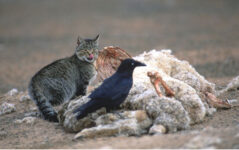
Pussy cat pussy cat, where have you been? Feral cats in the bush

I love cats, furry and friendly. I love kittens chasing feathers and butterflies. I do not love cats in the bush.
It is estimated that there are 5-6 million feral cats in Australia, and they are found in every part of the country from Tasmania to the Northern Territory. A single cat in the bush kills about 420 birds, mammals and reptiles every year. The death toll is growing as the cat population expands. They can breed twice a year and raise up to nine kittens in a litter.
Many Australian native animals are now extinct, and highly endangered species of animals and birds are being decimated because of feral cats. Cats are also carriers of several diseases that can be fatal to humans and domestic animals and birds including toxoplasmosis and sarcocystosis.
Control of feral cat numbers should be a priority for national, state and local governments. The urgency is recognised. Success can only be achieved with general support from the public.
I recently visited Piccaninny Plains, a vast property managed by Australian Wildlife Conservancy, spanning nearly 165,000 hectares between the Archer and Wenlock Rivers on the Cape York Peninsula. The open tropical grassland until recently was a cattle station and is unfenced so that animals roam freely. As cattle numbers have been reduced and traditional fire management practices reintroduced, grasses have regenerated and the banks of rivers and waterholes have been stabilised, benefitting native wildlife such as parrots, finches, doves and quail, bandicoot, possums, wallabies and gliders. The wetlands are important havens for migratory birds visiting from Papua New Guinea and as far away as Siberia.
Picca Plains field scientists’ active programs include implementation and evaluation of fire management practices, weed control and biological surveys. They are also involved in studying and removing feral animals such as pigs, cattle and horses that damage the wetlands, spoil the water and eat the eggs of emus, turtles and crocodiles. They rank feral cats their top concern.
During my visit, I learned that the management team had removed more than 300 cats from the property. The problem remains huge. Cats are smart, are active at night, range over a wide area and are elusive. Shooting or trapping cats is not practical. Chemical baits or sprays are currently too expensive. The numbers of animals and the vastness of the property rule out these management practices. Nevertheless, unless controlled, cats will wipe out most of the land animals and many of the birds.
This would not simply be distressing for nature-lovers. Biodiversity is essential for the processes that support all life on Earth, including humans. The widest possible range of animals, plants and micro-organisms is needed to support healthy ecosystems that we rely on to provide us with the air we breathe and the food we eat. Pollinators such as birds, bees and other insects are estimated to be responsible for a third of the world’s crop production. Agriculture also relies upon invertebrates that help to maintain the health of the soil that crops grow in. Life from the oceans provides the main source of animal protein for many people.
Trees, bushes, wetlands and wild grasslands such as those at Picca Plains naturally slow down water and help soil to absorb rainfall. When these are damaged or removed, they are not able to fulfil their role of preventing flooding. Plants clean the air and help tackle the global challenge of climate change by absorbing carbon dioxide. Coral reefs and mangrove forests act as natural defences protecting coastlines from waves and storms.
Of course, it is not all the fault of feral cats, but in Far North Queensland, they seem to be public enemy number one.



